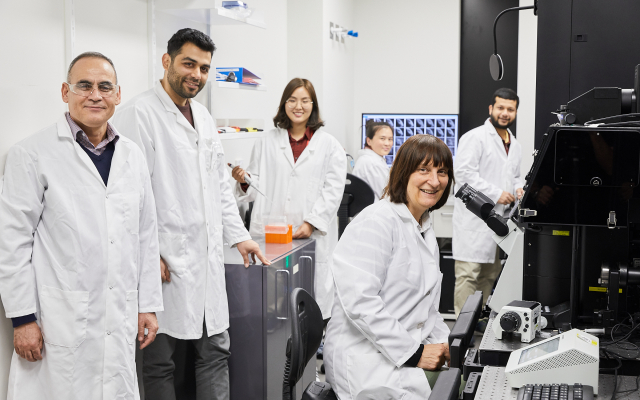
As a vibrant research field, biophotonics is exciting researchers the world over. Its primary goal? To create non-invasive, fast and effective ways to diagnose and treat disease.
Originally trained as a physicist, Professor Ewa Goldys had a lifelong aspiration of leading research that would have a positive impact on peoples’ lives. What followed was an exciting interdisciplinary research journey which has led her to the emerging field of biophotonics.
Today, she is the Deputy Director of the Australian Research Council (ARC) Centre of Excellence for Nanoscale BioPhotonics (CNBP). The CNBP was established in 2014 with a focus on driving the development of new light-based sensing tools that can measure biochemistry in cells and tissues at a nanoscale level.
“Biophotonics is the use of light to enhance our understanding of biological processes. The tools of the trade include advanced microscopes that can image deep into biological tissue and observe molecular-scale activity. A primary goal is to create non-invasive, rapid and effective ways to diagnose and treat disease,” explains Goldys.
One of her key research interests, and the focus of the last 10 years, is trying to understand how the colours and shapes of cells and tissues can be used to diagnose diseases such as cancer.
Although the key idea appears straightforward, it opened a vast research field ready for pioneering exploration. Together with her CNBP team, Goldys has just announced the development of a new, automated, non-invasive technique for diagnosing eye surface cancer (ocular surface squamous neoplasia).
Reported in August 2019 in clinical journal ‘The Ocular Surface’, the innovative method comprises the custom-building of an advanced imaging microscope in association with state-of-the-art computing and artificial intelligence operation. The results will make it possible to identify between diseased and non-diseased eye tissue, in real-time, through a simple imaging process using automated systems.
“There is no doubt that the application of light and nanotechnology to in vivo diagnostics represents a research frontier which will have significant societal impact. We hope to see real world translational outcomes that support clinicians clinicians in making improved diagnosis and health decisions for patients.
Professor Ewa Goldys, Deputy Director of the Australian Research Council (ARC) Centre of Excellence for Nanoscale BioPhotonics
“We have been able to detect the presence of cancer on the surface of the eye, in addition to mapping the location of abnormal tissue margins. This is a breakthrough because the only alternative way of diagnosing ocular cancer is through a biopsy. We can replace this unpleasant procedure by taking a colour photograph, which is completely unique in ophthalmology at present,” says Goldys.
“Conventional ophthalmology uses native signals from cells, and those signals carry colour information, but nobody, except us, is actually looking at the details of these colours. Once commercialised and transferred into the clinical setting, this method will significantly reduce the need for biopsies, prevent therapy delays and, we believe, make treatment more effective for patients.”
According to Goldys, the technology has potential for widespread use on an outpatient basis, also in low resource settings, where there may be a shortage of pathology equipment and associated specialists.
“Now that we’ve got great results from working with patients’ samples, the next steps are to attract suitable clinical and industry partners to make the system practical and workable in a clinical setting,” Goldys continues.
“Our aim is to be able to incorporate our design into standard ophthalmology systems—similar to that used by opticians and optometrists when undertaking regular eye examinations.”
Professor Goldys was attracted to UNSW in 2018 through UNSW’s Strategic Hire and Retention Program (SHARP), established to draw world-class research leaders to the institution. She decided to join UNSW because of its reputation as a top Australian university, strong connections to the local hospitals and the University’s experience in research commercialisation.
“Our biophotonics research is strongly translational, and I believe UNSW is the best home for it as it allows me to take advantage of the scale and support that exists here.”
In addition to major advances in the early detection of eye cancer, Goldys says the non-invasive diagnostics using light that she and her CNBP team are developing can be applied across a variety of different medical scenarios.
“I am deeply involved in several clinical partnerships in areas as diverse as neurology, where we are working on the non-invasive early detection of neuronal diseases; kidney disease, where I’m working with clinicians to develop new, non-invasive diagnostic tests; and in reproductive medicine, where our technologies are able to improve the rates of IVF success,” Goldys continues.
“There is no doubt that the application of light and nanotechnology to in vivo diagnostics represents a research frontier which will have significant societal impact. We hope to see real world translational outcomes that support clinicians in making improved diagnosis and health decisions for patients.”
They are obviously on to something. The CNBP researchers have, to date, received funding from ARC and other partners, in excess of $150 million.
Academic in profile
Professor Ewa Goldys achieved an international reputation for the development and application of advanced fluorescence techniques to biomedicine, nanotechnology and advanced materials. She is Deputy Director of the ARC Centre of Excellence in Nanoscale BioPhotonics, recognised with the 2016 Australian Museum ANSTO Eureka Prize for Innovative Use of Technology. She is a Fellow of the Australian Academy of Technology and Engineering and, internationally, a Fellow of the Optical Society and a Fellow of SPIE (Society for Optics and Photonics).
